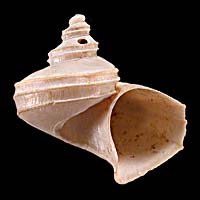|
< Previous family introduction |
|
|||||
 |
Family Capulidae |
|||||
|
The Capulidae is a small family of uncommon, mainly deep-water molluscs which vary widely in shell shape. The family name was originally used for the cap limpets, but the Trichotropidae, a group of tall-spired coiled shells, was combined with the Capulidae on the basis of similar animal structure. Although shell shape is widely variable, there is consistency in having a thick, often spiky periostracum. The anatomical feature that distinguishes the Capulidae is a long pseudoproboscis, used for feeding. This differs in structure to the normal molluscan proboscis; it is not tubular, but has a slit along the lower side. Some capulids are filter feeders, but others are ectoparasites. The Queensland species Capulus sycophanta lives on the outside of scallops, inserts the pseudoproboscis through a hole drilled in the scallop and steals waste products from their host. Other species position themselves near the aperture of fan worms and use the pseudoproboscis to steal mucus particles collected by the worm. Taxonomy of this family has been fluid in recent years. The family as understood now combines the Capulidae and Trichtropidae (also referred to as Siriidae or Lippistidae). All of the species listed under Capulidae in Iredale & McMichael's 1962 checklist have been transferred to other families, on anatomical evidence; Capulonix violaceus (Angas, 1867) to Amathinidae, Capulonix devotus (Hedley, 1904) to Hipponicidae and Capulonix australis (Lamarck, 1819) to Hipponicidae. All the NSW species currently assigned to Capulidae were previously classified in Trichotropidae, and have tall, coiled shells. Seven species of this family are known in NSW; two have tropical Indo-West Pacific distributions, three are restricted to eastern or southern Australia, and two are known only from a few shells, probably fossils, dredged from Sydney Harbour. All are uncommon or rare, mainly occurring subtidally, with only occasional beach specimens being collected. Family References There is no comprehensive reference to the family Coverage All species known from NSW are treated here. Identification Notes Shells of the NSW species of this family belie the family name of Capulide, or cap limpets, as they have tall, coiled shells. They are not readily distinguished on shell form from many other gastropod families. Most have strong spiral sculpture and little axial sculpture, with a narrowly to widely open umbilicus. The most distinctive family character is the periostracum, with weak to strong spines on the shoulder. |